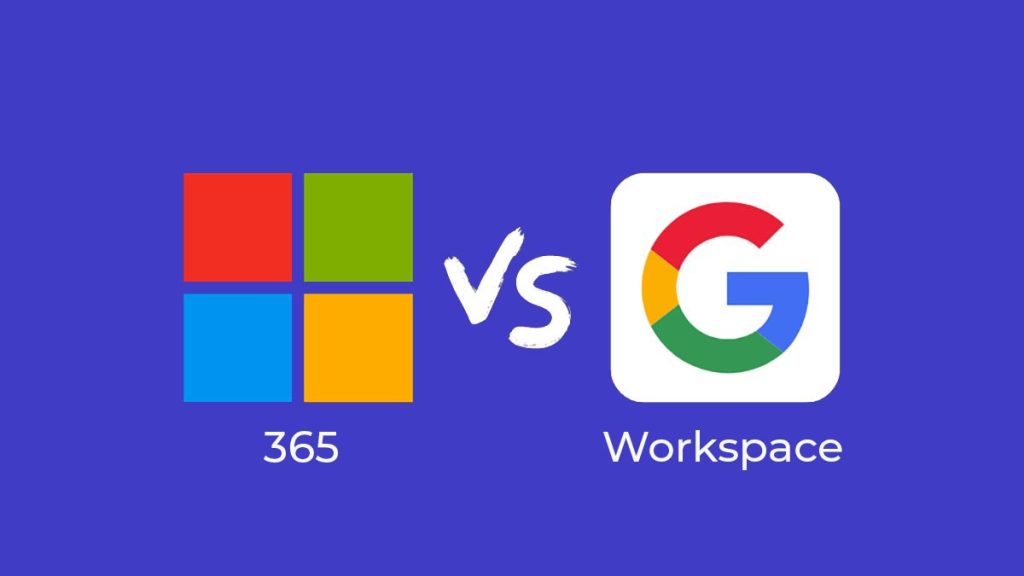
Google Workspace vs Microsoft 365, which one is better for you? Many firms, especially startups, have a challenging time deciding. Consider this blog post a quick overview of what to expect from each.
We will go through each product’s advantages and disadvantages as well as when and why you might prefer using one over the other.
Before we proceed, let us get one essential question out of the way.
What are Google Workspace and Microsoft 365 used for?
Microsoft 365 and Google Workspace are suites of productivity tools that allow users to carry out routine business tasks in the cloud through your web browser.
These business tasks include:
- sending emails
- managing calendars
- creating documents, spreadsheets, and presentations
- video conferencing
- file management
- team collaboration.
Additionally, Microsoft 365 offers a wide variety of desktop apps, which are programs you install on your computer rather than use online. This is their biggest advantage over Google and the core reason for picking them over the latter.
Both programs recently had name changes: Google Workspace was once known as “G Suite,” while Microsoft 365 was formerly known as “Office 365.”
Pros and cons of Google Workspace vs Microsoft 365
Where Microsoft 365 is Better than Google Workspace:
Most of them have desktop versions of Microsoft Office, which makes the product a far better match for any business whose clients depend on it being able to transmit, receive, and easily modify MS Office files. This is by far the most convincing justification for choosing 365.
While Google Workspace only offers a 14-day trial, the free trial is more liberal and allows you to.
In general, the 365 applications have greater features than their Google Workspace counterparts.
Unlike Google Workspace, Microsoft 365 allows you to adjust storage quotas for individual users, and the file storage and email storage quotas on the 365 entry plan are far more extensive than those offered by the Google Workspace entry-level plan.
Gmail lacks the ability to sort and organize emails as the desktop edition of Outlook does.
The participant limitations for video conferences are greater than those for Google Workspace.
With Microsoft 365, more sophisticated call management solutions are accessible.
Businesses that are solely Windows-based may find Microsoft 365 to be a better option because it offers additional programs (including Publisher and Access), as well as performance monitoring capabilities.
There are a few important Microsoft applications like Stream and Sway that lack direct Google alternatives.
Where Google Workspace is Better than Microsoft 365:
Technically speaking, Google Workspace allows you to produce documents for both Google Workspace and MS Office, but Microsoft 365 only permits you to do so.
File storage: Except for the entry-level plans, the Google plans provide more lenient file storage restrictions than their Microsoft 365 counterparts.
In contrast to Microsoft 365, which had collaboration capabilities added to an already-existing desktop-based product with a history of being used in a “local” context, Google Workspace was designed from the bottom up to be a collaboration-focused solution. As a result, the collaboration tools in Google Workspace are a little more robust and might help your team create a process that is really “cloud-based.”
With Google Workspace, you may get eDiscovery, site-building tools, email archiving, and legal holds on inboxes (among other sophisticated capabilities) for a reduced price.
If a strong internet connection is being used, the Google Workspace interfaces are clear and easy to use, and they load quickly (certainly faster than Microsoft Office desktop equivalents).
Businesses that employ several operating systems and devices can consider Google Workspace as a viable option.
The fact that Google Workspace is entirely cloud-based could inspire people to use the cloud more, with all the advantages this has for collaboration.
Microsoft’s comparable One Drive Files on Demand solution is less compatible with Windows and Mac operating systems than Google’s Drive Stream.
In Conclusion, Which Tool is Better for You?
Based on what we have covered above, it should be straightforward.
If collaborating on documents is your company’s bread and butter, then Google Workspace’s live collaboration toolkit will be your best friend. Its intuitive seamless and simplistic design will make it a joy to use for managers and employees alike.
If, however, you are looking for the most specialized and robust features in any given application, then you should go with Microsoft 365. Collaboration is still possible; it is just a bit more of a hassle.
Inside Telecom provides you with an extensive list of content covering all aspects of the tech industry. Keep an eye on our Technology section to stay informed and up-to-date with our daily articles